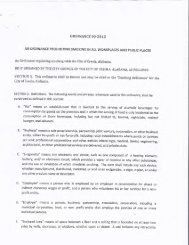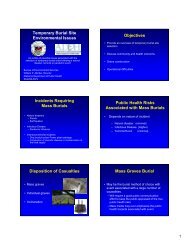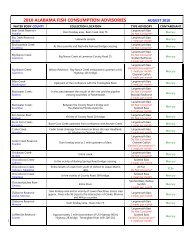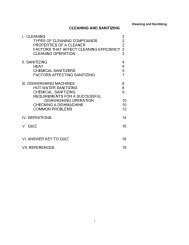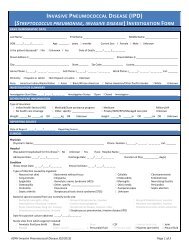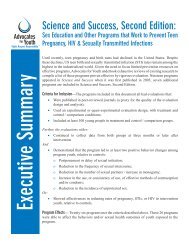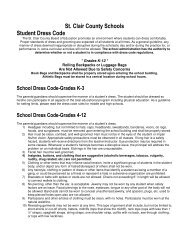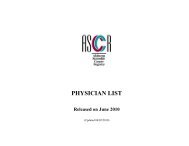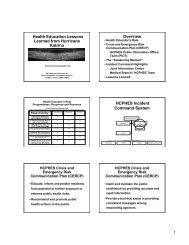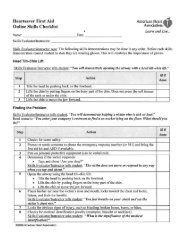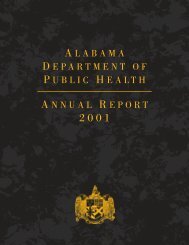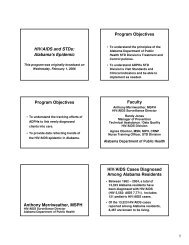CHEST TUBES
CHEST TUBES
CHEST TUBES
You also want an ePaper? Increase the reach of your titles
YUMPU automatically turns print PDFs into web optimized ePapers that Google loves.
<strong>CHEST</strong> <strong>TUBES</strong><br />
PURPOSE<br />
To familiarize and acquaint the transfer Paramedic with the skills and knowledge necessary to<br />
adequately maintain a chest tube drainage system in the interfacility transfer environment.<br />
COGNITIVE<br />
OBJECTIVES<br />
Identify the indications for a chest tube<br />
Discuss the most serious potential problem of a chest tube and its treatment<br />
Explain the importance of drainage monitoring<br />
Discuss what should be observed for in the drainage<br />
State the procedure to reestablish chest tube patency<br />
Discuss the four primary functions of a chest tube<br />
Discuss the proper maintenance of chest tubes<br />
Explain the significance of constant bubbling in the seal chamber<br />
PSYCHOMOTOR<br />
Observe the proper setup of a disposable chest tube drainage system<br />
AFFECTIVE<br />
Defend the rationale for not routinely “milking” the chest tube<br />
Explain the importance of maintaining a “dependent loop”<br />
Page 16
OVERVIEW<br />
The integrity of the lung is maintained by the negative pressure that is generated between the<br />
visceral pleura and the parietal pleura. If air is allowed to enter the potential space that<br />
exists between these two layers they will separate and the lung will collapse.<br />
Chest tubes have four primary functions:<br />
• Act as a drain for air and fluid that are present in the chest cavity<br />
• To replace the negative pressure required for chest wall integrity<br />
• To provide a water seal for the pleura which will prevent air from entering the system<br />
• Prevent the drainage from flowing back into the patient<br />
The typical disposable chest tube drainage unit consists of three separate chambers. In order,<br />
from the patient, they are the collection chamber, the water seal chamber, and the suction<br />
control chamber.<br />
The collection chamber will hold approximately 2.5 liters and is the area from which the chest<br />
drainage will be received. The water seal chamber will be 2 cm in depth. This provides the<br />
correct negative pressure for the chest tube unit. Bubbling should only be seen in the seal<br />
chamber during exhalation. Constant bubbling indicates that there is an air leak in the system.<br />
The final section is the suction control chamber which will be filled with water. This method is<br />
the safest way to regulate the amount of suction which is applied to the patient.<br />
The insertion site of the chest tube may vary greatly depending on the patient’s condition. The<br />
second intercostal space is a suitable site for a simple pneumothorax. In the event the patient<br />
has a hemothorax they may have a tube inserted into the sixth through the eighth intercostal<br />
spaces since the fluid will drain into the lower areas of the chest.<br />
INDICATIONS<br />
Any event, whether injury or surgery, that disrupts the integrity of the chest wall may<br />
necessitate the placement of a chest tube.<br />
MAINTENANCE<br />
• If it is permissible, the ideal position for the patient with a chest tube is the semi-Fowler’s<br />
position.<br />
Page 17
• Air and fluid evacuation may be enhanced by turning the patient every 2 hours, if<br />
permissible.<br />
• Frequently lift the latex tubing to drain into the collection chamber to prevent a possible<br />
obstruction<br />
• NEVER raise the chest tube drainage system above the level of the patient’s chest due to the<br />
fact that the contents will drain back into the patient.<br />
• Fluctuations in the water seal chamber of two to four inches, when the patient breathes, are<br />
considered normal.<br />
• Avoid creating loops in the drainage tube as clots may form.<br />
• Encourage the patient to breathe deeply and to cough.<br />
• Palpate the area around the insertion site for signs of subcutaneous emphysema.<br />
PROBLEMS<br />
The most serious complication of a chest tube is the development of a tension pneumothorax<br />
due to an obstructed drainage tube. A common cause of obstruction is not periodically lifting<br />
the tube thereby allowing the collected blood to clot. Frequent monitoring and draining of the<br />
latex tubing will prevent this from occurring.<br />
In the case of inadvertent chest tube removal the open wound should be treated as an open<br />
pneumothorax (“sucking chest wound”). Use an occlusive dressing, taped only on three sides<br />
if possible, and monitor the patient for signs of a developing tension pneumothorax.<br />
DRAINAGE MONITORING<br />
Be certain that the chest tube drainage system is in full view so that you may observe the<br />
drainage for the following:<br />
• Color<br />
• Consistency<br />
• Amount<br />
Any sudden changes in drainage are cause for alarm and the transferring, receiving or medical<br />
control facility should be contacted:<br />
• An increase in the amount of drainage may mean hemorrhaging<br />
• A decrease in the amount of drainage may mean an obstruction or a failure of the system<br />
Page 18
PROCEDURE FOR REESTABLISHING TUBE PATENCY<br />
In the event that the chest tube is no longer functioning, utilize the following procedure to<br />
reestablish patency:<br />
• If permissible, reposition the patient<br />
• If there is a clot visible in the tubing, straighten and raise the latex tubing to increase<br />
drainage<br />
• Squeeze and release the tubing in an attempt to move the clot<br />
• Only after the above steps have been attempted and failed should “milking’ or stripping the<br />
tube towards the receptacle be attempted. “Milking” is a process where one pinches the latex<br />
tubing and, while maintaining pressure on the tubing, moves their fingers toward the<br />
receptacle.<br />
• Routine stripping or “milking” of the chest drainage tube is to be avoided due to:<br />
Generation of excessive negative pressures<br />
Rupture of the alveoli<br />
Persistent pleural leak<br />
Page 19



